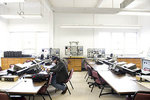
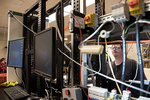
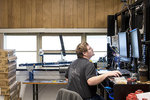
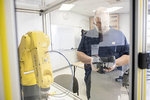
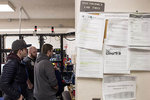
In March 2017, students in two programs at Centralia College had not yet graduated, but the majority of them had already been hired on by Intel, an American multinational corporation and technology company.
The mechatronics and electronics, robotics and automation programs in all had 13 students last year. Of those students, the eight that interviewed with Intel all received job offers, with an additional student who was hired at Boeing.
Each year, Intel makes a trip to the Centralia College campus to interview students. In years past, the program has had an employment rate of 100 percent.
David Peterson, associate professor of mechatronics and ERA, said that everyone who typically wants a job will get one. Right now the program does not have enough students to meet the demands of the industry.
The industry is expected to grow by 4 percent by the year 2020, and ERA technicians and those in the electronics industry will continue to be in high demand, according to the college’s website.
“It’s such a relief,” Nicholas Palermo, 27, said of his future employment at Intel. “More often than not you graduate from college and you have to go through the process to find a job and we’re just trying to find a place to live in Oregon at this point.”
Michael Kelly, 27, said his goal was always to get a job at Intel. He worked hard and took extra classes to show he is qualified for the position.
“To finally know that we get a position as soon as we are done with school, it feels really good,” he said. “It’s exciting.”
Kelly was drawn to Intel because of the benefits the company provides and the room for upward advancement.
Peterson said many technology companies like Intel will pay for its employees to complete a bachelor’s degree later on to further their education.
Don Abell, 47, was drawn to the electronics, robotics and automation program because he had always been interested in the technology behind it. At first he had not selected a company to work for, but after hearing the pitch from Intel, he was sold.
“From that point on, I was like ‘That’s what I want to do,’” Abell said. “Anybody who is even halfway interested should at least come check it out. It’s a really good program and has a good history of placing people in jobs.”
Those heading to Intel will be manufacturing technicians with a median starting income of $57,850 a year. Medical and retirement benefits are also available at most jobs.
The programs are housed under the same department and are very similar. Mechatronics focuses more on industrial technology components, like the installation, tuning and maintenance of equipment. Electronics, robotics and automation, like its name suggests, centers more around the electrical components.
Utilizing the machinery that is standard across the fields, students get a hands-on opportunity to gain experience throughout the two year associate program.
Daniel Whalen, assistant professor, said mechatronics combines many skill sets such as control systems, computers, mechanical systems and digital control systems. Those in both mechatronics and ERA can find jobs in fields that include aerospace, defense systems, manufacturing and materials processing industries.
The program is aimed to be flexible, Peterson said. The lectures are videotaped and put online and the instructors are willing to work with students to accommodate other responsibilities they may have.
And Peterson also said that if a company is looking to move to the area, the instructors will train students to ensure there is a capable workforce.
In 2017 about 75 percent of the students who graduated from the programs left the area to work at larger companies. The remaining 25 percent typically get jobs locally at companies like Lineage Logistics, Imperial Fabricating Co. or Darigold.
The hope is to continually grow the program so more students are funneled into the local jobs, instead of moving away from the area, Whalen said.
The programs are now housed on the third floor of the TransAlta Commons building, providing a larger space. The mechatronics program received a $300,000 federal grant in 2016, according to Whalen, which will allow for the purchase of new equipment and expanded opportunity.